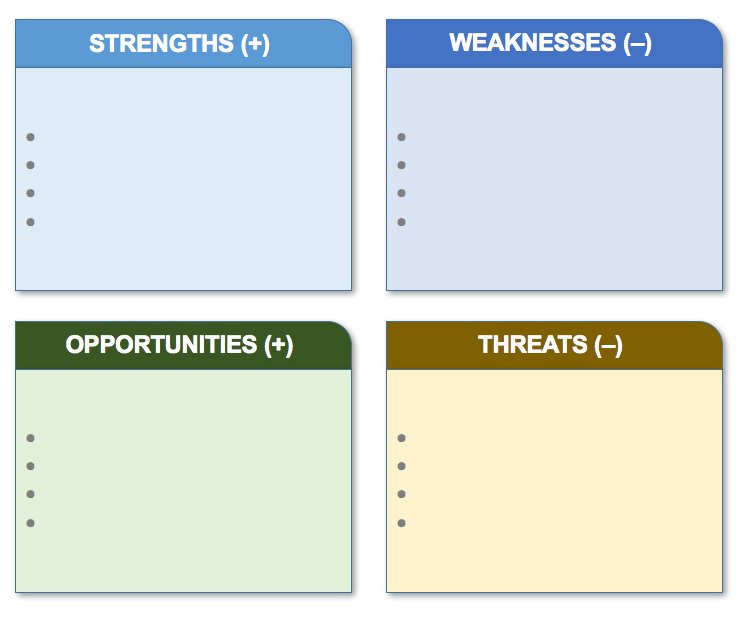SWOT Analysis
SWOT Analysis
Analysis of your Strengths, Weaknesses, Opportunities, and Threats (SWOT) is a useful technique for understanding yourself. You are most likely to succeed in life if you use your strengths to their fullest extent, cover or overcome your weaknesses, make use of your opportunities, and identify threats to your self development.
So how you go about doing a SWOT Analysis? Just take four sheets of paper. Label them Strengths, Weaknesses, Opportunities, and Threats.
Think about your strengths in relation to the people around you. On the paper labelled “Strengths” write the answers to the following questions. Write down even the smallest or most trivial thing. Make as long a list as possible:
- What skills, certifications, education, connections, or other advantages do you have?
- What do you do better than some of the people you know?
- What personal resources can you access?
- What positive qualities do others see or appreciate in you?
- Which of your achievements are you most proud of?
- What values do you believe in?
- What connections do you have?
Now take the paper labelled “Weaknesses”. Write the answers to the following questions. Be realistic and honest. Is is best to face unpleasant truths.
- What tasks do you usually avoid?
- What do people around you see as your weaknesses?
- What are the things about which you are not confident?
- What habits affect your work?
- What makes you hesitant to do things?
- What do you see as your weakness?
Next, on the “Opportunities” paper answers to the following questions.
- What technology can help you?
- Who can you get help from?
- How can you take advantage to current situations and circumstances?
- Are there things that people around you are not doing, that you could do?
- Is there a need that no one is filling?
- Could you take on some of the work of others around you?
- Is there a class, a role or a project that you can take on to learn new skills?
Now take out the “Threats” paper. Answer the following questions:
- What obstacles do you currently face.
- Is someone competing with you?
- Is the demand for the things you do, or your job, changing?
- Are your skills becoming outdated?
Implementation Plan

Put the papers away. Take them out every day, and keep adding to each paper, till you can add no more Strengths, Weaknesses, Opportunities, or Threats.
Now, take out a fresh sheet of paper, and label it “Actions”. Look at your “Weaknesses” For each weakness that you have listed, write out, in detail, how you can overcome it.
Look at your “Strengths”, and ask yourself how you can use these to overcome or cover the weakness, Understand that you may not be able to overcome all your weaknesses. However, you can cover up your weaknesses with your strengths.
Look at your “Opportunities”. Ask yourself whether these can help you to develop new strengths that can eliminate or overcome some of your weaknesses.
Finally, look at your “Threats”, and think about how you can avoid them. see if you can use your strengths, or use your opportunities to develop new strengths to overcome them.
If ideas do not strike you, put away the papers, and come back to them each day, till you have listed out how you can overcome your weaknesses and your threats.
Now, take a fresh sheet of paper and label it “Implementation Plan”. Look at your “Actions” paper, and reorder your actions, starting with the one that is easiest to implement, with the one that you think is most difficult to implement at the last.
Now, start with the first action on the “Implementation Plan”. Implement it. Once it is completed, cross it out, and move to the next action in the plan. Continue to do this till every single action has been implemented. Some actions take longer to implet than others. Do not give up. Keep at it.
With every action implemented, you will become a BETTER PERSON.
